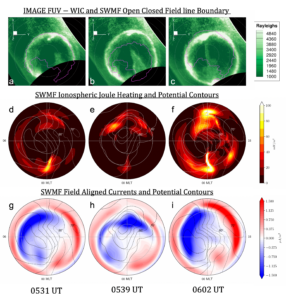Theta aurora, also referred to as transpolar auroral arcs, are sun-aligned auroral arcs that span across the entire polar cap connecting the nightside and dayside auroral oval in a shape that resembles the letter theta. Theta aurora are generated by solar wind-magnetosphere-ionosphere coupling processes during periods of northward interplanetary magnetic field, typically leading to quiet geomagnetic conditions. Their formation mechanisms are highly debated; there is evidence to support formation on both open and closed field lines as well as evidence to support separate formation mechanisms in the dayside and nightside polar cap region. Here we study the complex solar wind – magnetosphere coupling mechanisms involved in the formation and dynamics of theta aurora using both observations and numerical simulations.
 |
Theta aurora are a particular form of auroras that occur over the polar cap that is usually void of auroral precipitation. The top row shows three satellite images over a 30-min period showing auroral oval (lighter shades) over the southern hemisphere polar regions. The series shows the growth of the theta aurora – the bright tongue coming from the nightside (from the bottom) and reaching toward the dayside auroral oval (at the top). The second and third rows show the SWMF simulation results of Joule heating and field-aligned currents at the time steps. All results are from the southern hemisphere polar region. Image credit: Shannon Hill, manuscript in preparation. |
